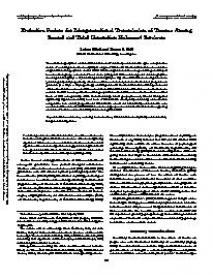Protective Factors for Intergenerational Transmission of Trauma Among Second and Third Generation Holocaust Survivors
The current study explored whether differentiation of self and family communication styles were protective factors of secondary traumatic stress (STS). A sample of 215 Jewish Americans/Canadians whose families emigrated from Europe prior to or after World War II completed an online survey consisting of self-report measures. Four groups were created based on the participants’ Holocaust background and demographics: Second generation (2G; n = 77) and third generation (3G; n = 52), who self identified as having at least one parent or grandparent, respectively, who is/was a Holocaust survivor, and a matched control group for each generation (n = 50; n = 36, respectively) consisting of Jewish Americans/Canadians of European descent with no direct relatives who were Holocaust survivors. 2G and 3G referenced the Holocaust as the traumatic event on the STS measure, while the control group referenced non-Holocaust events. Results showed that levels of STS were generally within the normal range for all groups; however, 2G and 3G reported significantly higher levels of STS, lower levels of differentiation of self, and poorer family communication compared to their control groups. Greater differentiation of self and better family communication were associated with lower levels of STS. Differences between groups were consistent with other studies suggesting a mixture of resilience and vulnerability factors among 2G and 3G.
Geachte bezoeker,
De informatie die u nu opvraagt, kan door psychotraumanet niet aan u worden getoond. Dit kan verschillende redenen hebben,
waarvan (bescherming van het) auteursrecht de meeste voorkomende is. Wanneer het mogelijk is om u door te verwijzen naar de bron
van deze informatie, dan ziet u hier onder een link naar die plek.
Als er geen link staat, kunt u contact opnemen met de bibliotheek,
die u verder op weg kan helpen.
Met vriendelijke groet,
Het psychotraumanet-team.
In: Psychological Trauma: Theory, Research, Practice, and Policy ; ISSN: 1942-9681 | 5 | 4 | 384-391
https://doi.org/10.1037/a0028455


